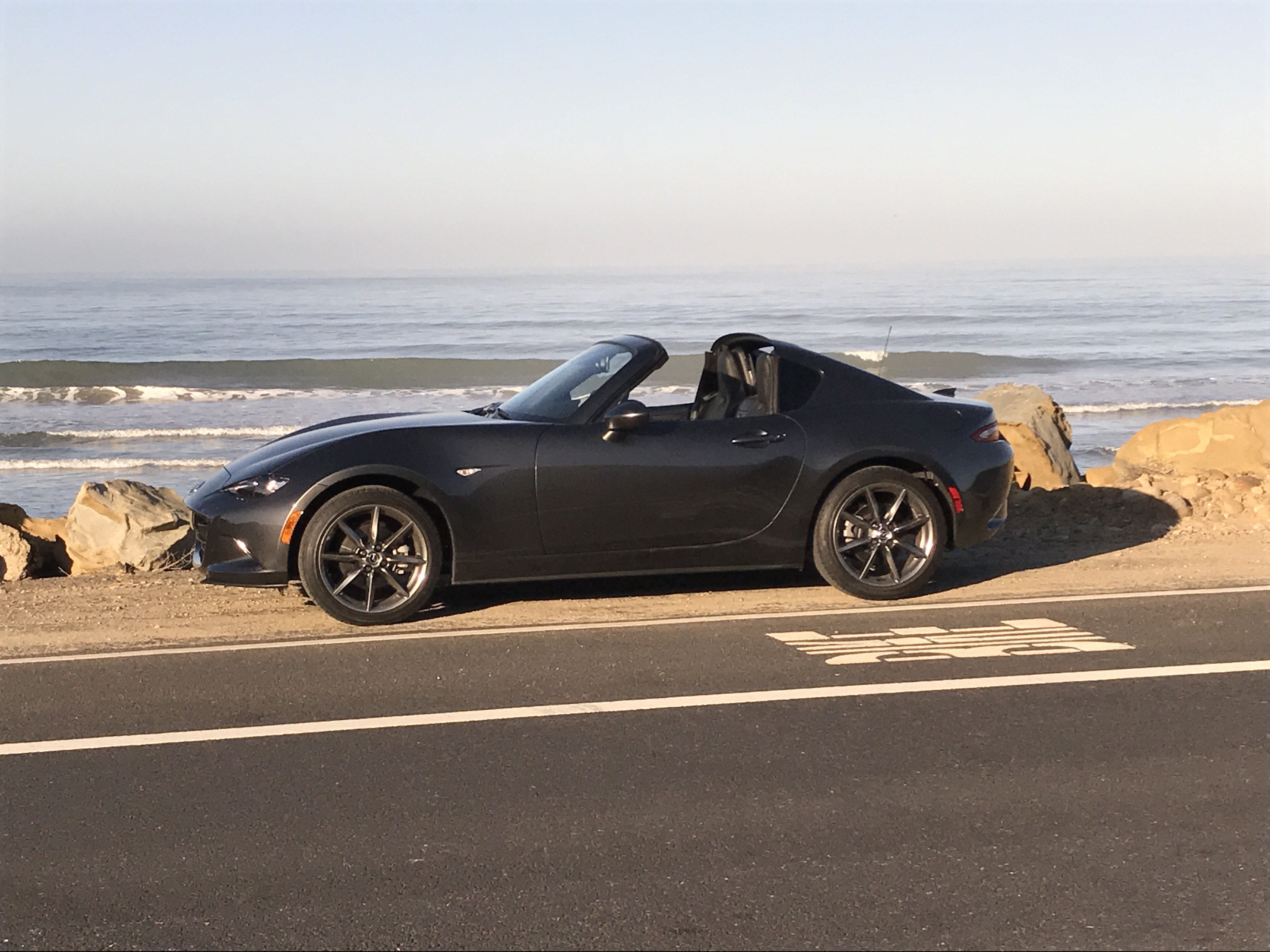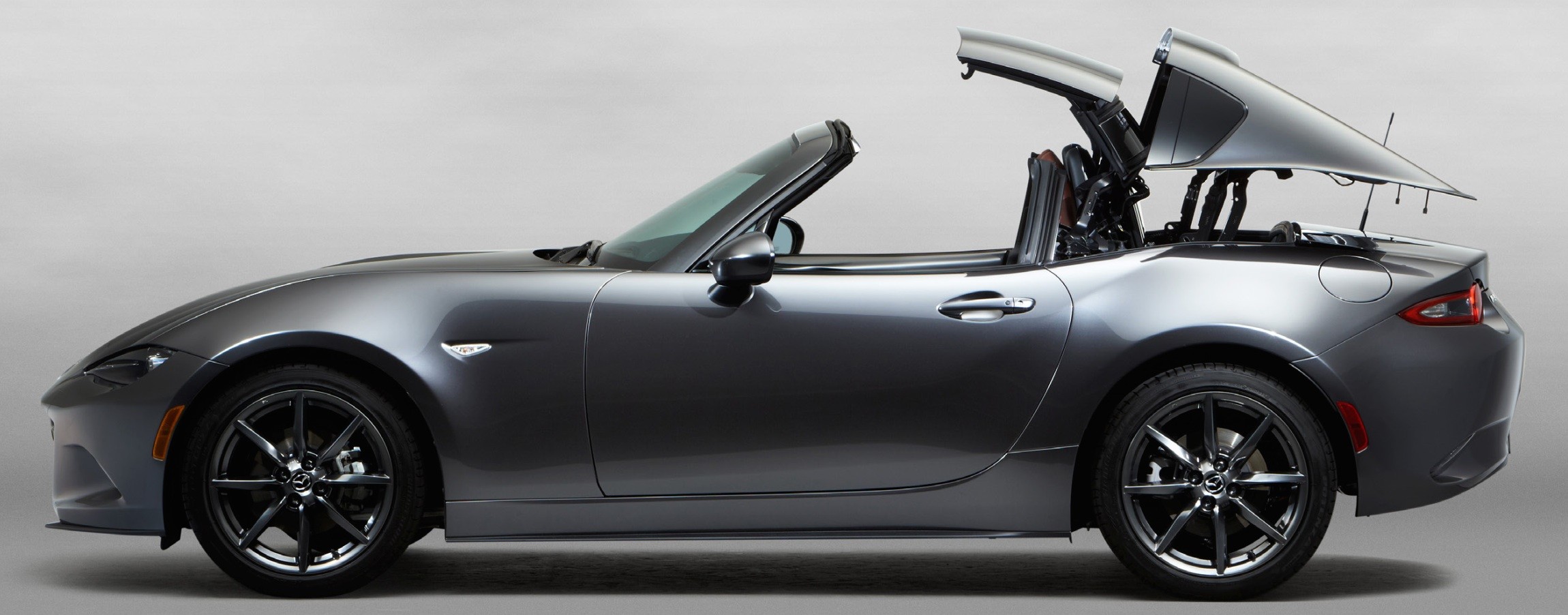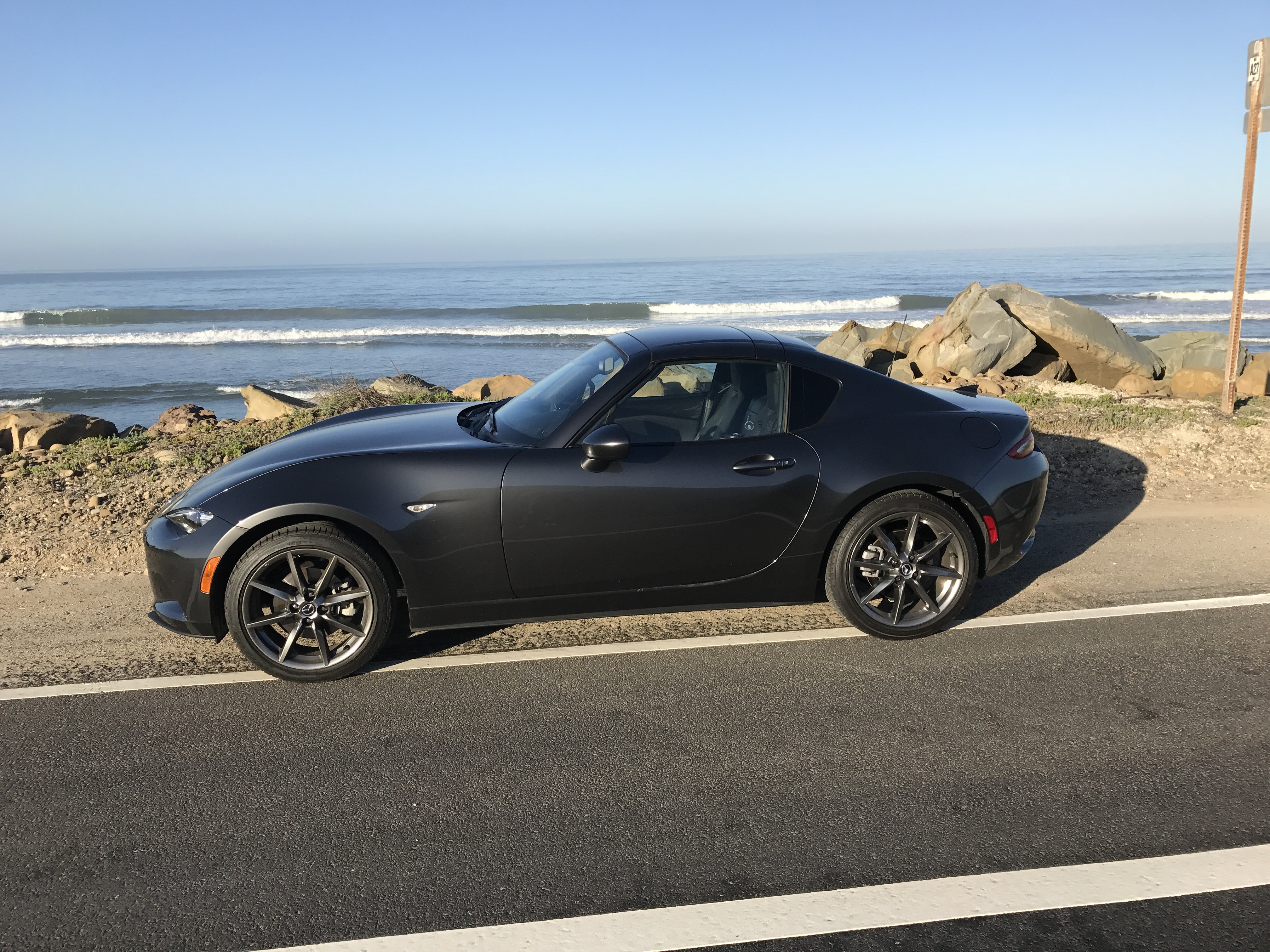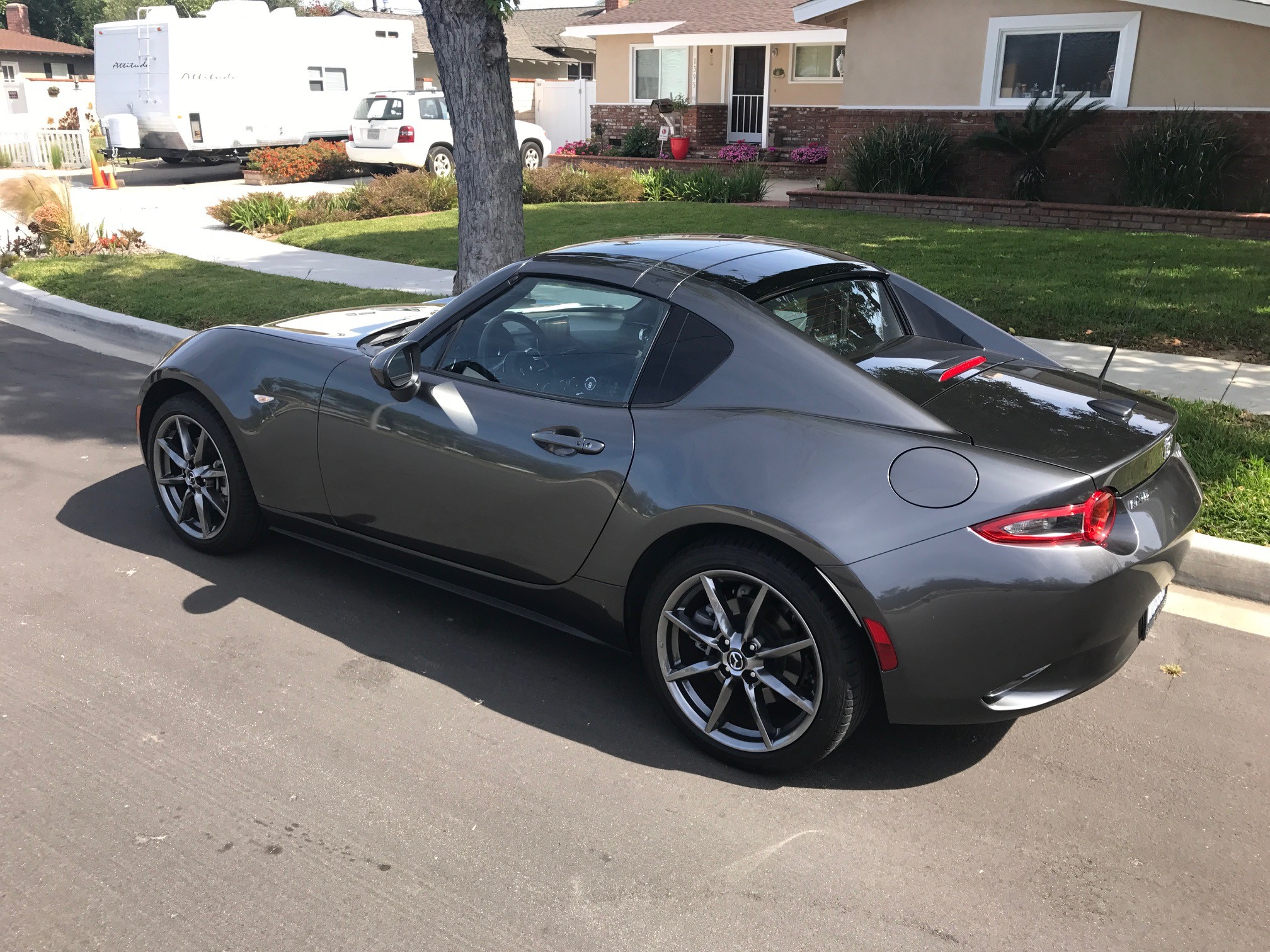 Vehicles for Ride Me reviews, be they Kias, Chevys or Lincolns, are dropped off in front of my house. The two times Gentleman Jack across the street has come over to admire a loaner car were nine months ago, after a Soul Red Metallic 2016 Mazda Miata MX-5 convertible was dropped off, and last week, upon delivery of a Machine Gray Metallic 2017 Mazda Miata MX-5 Grand Touring RF. Coincidence?
Vehicles for Ride Me reviews, be they Kias, Chevys or Lincolns, are dropped off in front of my house. The two times Gentleman Jack across the street has come over to admire a loaner car were nine months ago, after a Soul Red Metallic 2016 Mazda Miata MX-5 convertible was dropped off, and last week, upon delivery of a Machine Gray Metallic 2017 Mazda Miata MX-5 Grand Touring RF. Coincidence?
The first thing I had to show (off to) him on the newest addition to Mazda’s MX-5 family was the power retractable hardtop roof, which by the flip of a switch pops up and behind the area above riders’ heads before dropping into a narrow hidden compartment between the convertible’s two bucket seats and the trunk. I didn’t time it, but Mazda says the top opens or closes in 13 seconds. “That’s cool!” remarked Gentleman Jack. “Wow, are those paddle shifters?” Indeed they were, on the leather-wrapped steering wheel.
What’s really cool about this convertible, as a longtime former owner of a Cadillac with a canvas roof, is the option to go hard- or no top. As much as I loved my old ElDo, the least amount of fun driving it was in pounding rain, when the thwapping noise of water against canvas drowned out the radio, conversations with passengers and, most distressingly, the voices in my head. Those would be the voices screaming, “Make the goddamn noise stop!”
 I got to witness how the better, hardtop half lives on a weekend trip to San Diego. The ride down was sunny, so I went topless. The jaunt back was punctuated by a late season storm, so up went the hardtop. Water against metal can for sure be loud, but it was manageable by cranking up the sound coming out of the MX-5’s high-definition audio system and nine Bose speakers, prompting the voices in my head to note, “This ain’t so bad.”
I got to witness how the better, hardtop half lives on a weekend trip to San Diego. The ride down was sunny, so I went topless. The jaunt back was punctuated by a late season storm, so up went the hardtop. Water against metal can for sure be loud, but it was manageable by cranking up the sound coming out of the MX-5’s high-definition audio system and nine Bose speakers, prompting the voices in my head to note, “This ain’t so bad.”
Now, the 2016 Soul Red Metallic version had a manual transmission that made it really fun to drive, especially along open stretches of PCH. The ’17 Machine Gray Metallic MX-5 was an automatic, which I feared would be disappointing—until I found myself in multiple bumper-to-bumper freeway traffic scenarios that would have made using a stick shift cumbersome. The lesson this taught me: When choosing the nostalgia of a stick versus the practicality of an automatic, consider which driving situations you are going to most find yourself in. Weekend fun car? Stick! Every-day commuter? Automatic, baby! Not that I wouldn’t want to give a manual 2017 MX-5 a spin, for comparison sake, of course. (Hint-hint, Mazda!)
 What really made me appreciate the tester was my first trip A.M. (After MX-5) in my personal four-cyclinder sedan, which I found myself flooring to get on the freeway as well as to keep up with the flow of traffic. That’s because I’d grown accustomed to the MX-5’s SKYACTIV-G 2.0-liter, four-cylinder, which pushes 148 pound-feet of torque at 4,600 rpm and 155 horsepower at 6,000 rpm. The six speed, rear-wheel drive wonder routinely got me up to 80 mph lickedy split—and kept me there—with mere gentle pushes of the accelerator.
What really made me appreciate the tester was my first trip A.M. (After MX-5) in my personal four-cyclinder sedan, which I found myself flooring to get on the freeway as well as to keep up with the flow of traffic. That’s because I’d grown accustomed to the MX-5’s SKYACTIV-G 2.0-liter, four-cylinder, which pushes 148 pound-feet of torque at 4,600 rpm and 155 horsepower at 6,000 rpm. The six speed, rear-wheel drive wonder routinely got me up to 80 mph lickedy split—and kept me there—with mere gentle pushes of the accelerator.
Visiting family and friends in San Diego, one fellow decided he was going to write part of this review for me, as he wanted it emphatically explained to newbies that the Miatas of twentysomething years ago looked … well … feminine. (Not that there’s anything wrong with that if that is what you’re into.) The pinch-hitting reporter felt the latter-day Miata he was now feasting his eyes on had more masculine, mini-muscle car lines. To me, standing outside and looking at the side profile, I was reminded of the Datsun 240Zs of the 1970s. However, peering out the windshield from the driver’s seat evoked feelings of being in an Italian sports car on a winding cliffside road as Grace Kelly sat by my side, my long white scarf whipping in the wind as plans for the night’s cat burglary danced in my head. Alas, 90 percent of the MX-5 parts came from Japan, which is where it was manufactured.
Other things I liked about the car: the 4.6-inch, full-color, thin-film-transistor display; the options throughout the cabin to adjust the audio, navigation and Bluetooth phone system, the rain-sensing wipers, the automatic front lighting system and the i-ACTIVSENSE blind spot and rear cross traffic alerts.
However, I am no fan of this particular car’s i-ACTIVSENSE lane departure warning system, which was so touchy as to be annoying. Perhaps there is a way to adjust it so it’s less sensitive. Because I am in the habit of looking over my shoulder to change lanes, I found it troubling to find myself staring into a black barrier about where a rear vent window would be. I’ll chalk this up to needing to trust that i-ACTIVSENSE blind spot alert.
Something I found myself and passengers wondering about was the lack of a rearview camera when putting the MX-5 in reverse. I believe by now everyone figures if you have a screen on the dash for audio and navigation, a rearview camera is a given. I explained to the curious that perhaps the space needed for a small aluminum trunk lid made the placement of rear cameras impossible. That’s a total guess, BTW.
Anyone interested in an MX-5 should know that trunk space is very small. It was like putting a puzzle together to get two carry-on bags, two toiletry bags and four bottles of wine in there. There is only a small glove box between and behind the two riders. It was a good thing the plastic bottle in the cup holder adjacent to my left shoulder was collapsible, because my meaty arm continually smashed it.
But small sports cars are for driving excitement, not the kind of comfort you’re afforded in luxury cars, SUVs and party buses. That said (or, actually, written), the leather trimmed sport seats and head rests felt very nice, and I discovered how to make the teeth chattering stop on bumpy roads: Go faster.
 The EPA estimated fuel economy is a respectable 29 mpg (26 city, 35 highway). The fuel economy and greenhouse gas rating—Trump hasn’t gotten rid of this already?—is 7, with 10 being best, and the smog rating is a 6 on the same scale.
The EPA estimated fuel economy is a respectable 29 mpg (26 city, 35 highway). The fuel economy and greenhouse gas rating—Trump hasn’t gotten rid of this already?—is 7, with 10 being best, and the smog rating is a 6 on the same scale.
The $33,825 manufacturer’s suggested retail price includes as standard equipment everything already mentioned in this article as well as: 17-inch alloy wheels, high performance tires, LED lights all around, heated, power side mirrors (with auto dimming on the driver side and rearview), power locks and windows, keyless entry and push-button ignition, anti-lock brakes (front ventilated disc, read solid disc), tire pressure monitoring system, front and rear stabilizer bars, dual vanity mirrors, double-pinion power assist steering, glass rear window with defogger, audio system with auxiliary jack, two USB inputs, SiriusXM satellite radio, cruise control, automatic air conditioning, heated seats and dual front and side air bags. Oh, and something convertible owners will appreciate: an anti-theft engine immobilizer.
My test ride had a $34,960 MSRP when you figured in the $300 paint job and $835 in various fees. The base model price is $31,555.

OC Weekly Editor-in-Chief Matt Coker has been engaging, enraging and entertaining readers of newspapers, magazines and websites for decades. He spent the first 13 years of his career in journalism at daily newspapers before “graduating” to OC Weekly in 1995 as the alternative newsweekly’s first calendar editor.

